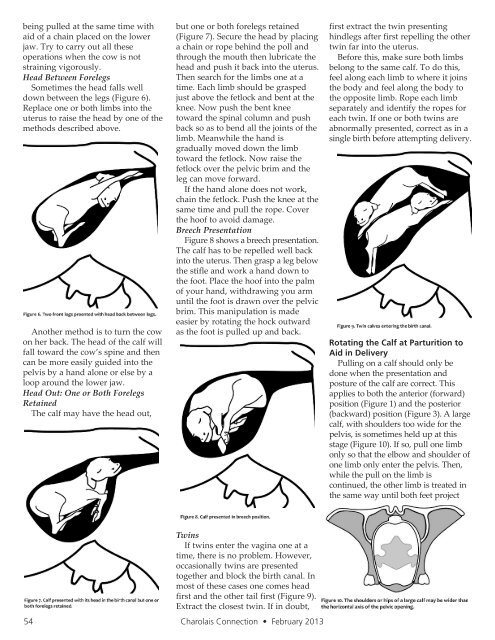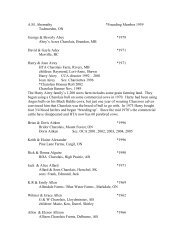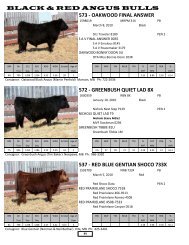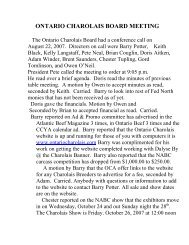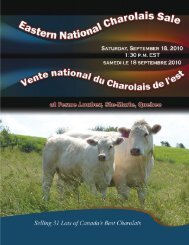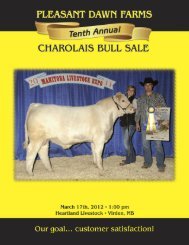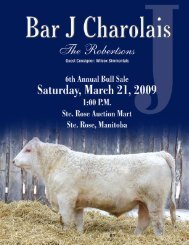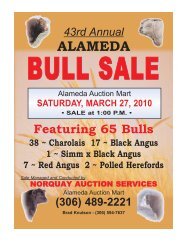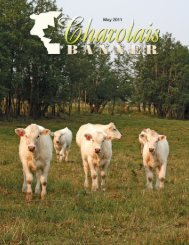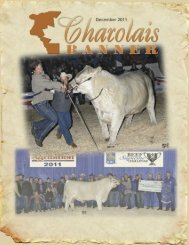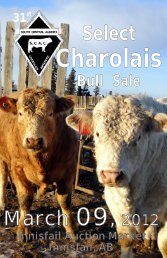Create successful ePaper yourself
Turn your PDF publications into a flip-book with our unique Google optimized e-Paper software.
eing pulled at the same time with<br />
aid of a chain placed on the lower<br />
jaw. Try to carry out all these<br />
operations when the cow is not<br />
straining vigorously.<br />
Head Between Forelegs<br />
Sometimes the head falls well<br />
down between the legs (Figure 6).<br />
Replace one or both limbs into the<br />
uterus to raise the head by one of the<br />
methods described above.<br />
Another method is to turn the cow<br />
on her back. The head of the calf will<br />
fall toward the cow’s spine and then<br />
can be more easily guided into the<br />
pelvis by a hand alone or else by a<br />
loop around the lower jaw.<br />
Head Out: One or Both Forelegs<br />
Retained<br />
The calf may have the head out,<br />
but one or both forelegs retained<br />
(Figure 7). Secure the head by placing<br />
a chain or rope behind the poll and<br />
through the mouth then lubricate the<br />
head and push it back into the uterus.<br />
Then search for the limbs one at a<br />
time. Each limb should be grasped<br />
just above the fetlock and bent at the<br />
knee. Now push the bent knee<br />
toward the spinal column and push<br />
back so as to bend all the joints of the<br />
limb. Meanwhile the hand is<br />
gradually moved down the limb<br />
toward the fetlock. Now raise the<br />
fetlock over the pelvic brim and the<br />
leg can move forward.<br />
If the hand alone does not work,<br />
chain the fetlock. Push the knee at the<br />
same time and pull the rope. Cover<br />
the hoof to avoid damage.<br />
Breech Presentation<br />
Figure 8 shows a breech presentation.<br />
The calf has to be repelled well back<br />
into the uterus. Then grasp a leg below<br />
the stifle and work a hand down to<br />
the foot. Place the hoof into the palm<br />
of your hand, withdrawing you arm<br />
until the foot is drawn over the pelvic<br />
brim. This manipulation is made<br />
easier by rotating the hock outward<br />
as the foot is pulled up and back.<br />
first extract the twin presenting<br />
hindlegs after first repelling the other<br />
twin far into the uterus.<br />
Before this, make sure both limbs<br />
belong to the same calf. To do this,<br />
feel along each limb to where it joins<br />
the body and feel along the body to<br />
the opposite limb. Rope each limb<br />
separately and identify the ropes for<br />
each twin. If one or both twins are<br />
abnormally presented, correct as in a<br />
single birth before attempting delivery.<br />
Rotating the Calf at Parturition to<br />
Aid in Delivery<br />
Pulling on a calf should only be<br />
done when the presentation and<br />
posture of the calf are correct. This<br />
applies to both the anterior (forward)<br />
position (Figure 1) and the posterior<br />
(backward) position (Figure 3). A large<br />
calf, with shoulders too wide for the<br />
pelvis, is sometimes held up at this<br />
stage (Figure 10). If so, pull one limb<br />
only so that the elbow and shoulder of<br />
one limb only enter the pelvis. Then,<br />
while the pull on the limb is<br />
continued, the other limb is treated in<br />
the same way until both feet project<br />
Twins<br />
If twins enter the vagina one at a<br />
time, there is no problem. However,<br />
occasionally twins are presented<br />
together and block the birth canal. In<br />
most of these cases one comes head<br />
first and the other tail first (Figure 9).<br />
Extract the closest twin. If in doubt,<br />
54 <strong>Charolais</strong> Connection • <strong>February</strong> <strong>2013</strong>


